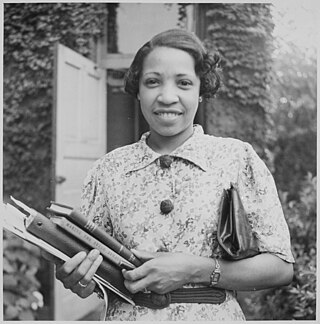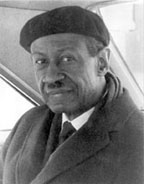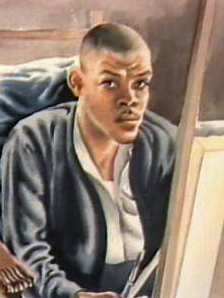Related Research Articles

Lois Mailou Jones (1905–1998) was an artist and educator. Her work can be found in the collections of the Smithsonian American Art Museum, The Metropolitan Museum of Art, the National Museum of Women in the Arts, the Brooklyn Museum, the Museum of Fine Arts, Boston, Muscarelle Museum of Art, and The Phillips Collection. She is often associated with the Harlem Renaissance.

David C. Driskell was an American artist, scholar and curator recognized for his work in establishing African-American Art as a distinct field of study. In his lifetime, Driskell was cited as one of the world's leading authorities on the subject of African-American Art. Driskell held the title of Distinguished University Professor of Art Emeritus at the University of Maryland, College Park. The David C. Driskell Center at the University of Maryland, is named in his honor.

The National Museum of African American History and Culture (NMAAHC), colloquially known as the Blacksonian, is a Smithsonian Institution museum located on the National Mall in Washington, D.C., in the United States. It was established in 2003 and opened its permanent home in 2016 with a ceremony led by President Barack Obama.

James Amos Porter was an African-American art historian, artist and teacher. He is best known for establishing the field of African-American art history and was influential in the African American Art movement.
The James A. Porter Colloquium on African American Art and Art of the African Diaspora is an annual event hosted and sponsored by Howard University.

Alma Woodsey Thomas was an African-American artist and teacher who lived and worked in Washington, D.C., and is now recognized as a major American painter of the 20th century. Thomas is best known for the "exuberant", colorful, abstract paintings that she created after her retirement from a 35-year career teaching art at Washington's Shaw Junior High School.
James Vernon Herring was an African-American artist and professor of art at Howard University.

Keith Anthony Morrison, Commander of Distinction (C.D.), born May 20, 1942), is a Jamaican-born painter, printmaker, educator, critic, curator and administrator.
Renée Stout is an American sculptor and contemporary artist known for assemblage artworks dealing with her personal history and African-American heritage. Born in Kansas, raised in Pittsburgh, living in Washington, D.C., and connected through her art to New Orleans, her art reflects this interest in African diasporic culture throughout the United States. Stout was the first American artist to exhibit in the Smithsonian's National Museum of African Art.
Merton Daniel Simpson was an American abstract expressionist painter and African and tribal art collector and dealer.
Momodou Ceesay is an artist and author.

Céline Marie Tabary was an artist and arts professor at Howard University who championed African-American art in 1940s Washington, D.C. She emigrated from France in 1938, teaching and working in Washington, D.C. through the 1950s, before returning to France. Tabary won the Landscape Prize in 1944 from the National Museum, Washington, D.C.
Martha Jackson Jarvis is an American artist known for her mixed-media installations that explore aspects of African, African American, and Native American spirituality, ecological concerns, and the role of women in preserving indigenous cultures. Her installations are composed using a variety of natural materials including terracotta, sand, copper, recycled stone, glass, wood and coal. Her sculptures and installations are often site-specific, designed to interact with their surroundings and create a sense of place. Her works often focus on the history and culture of African Americans in the southern United States. In her exhibition at the Corcoran, Jarvis featured over 100 big collard green leaves, numerous carp and a live Potomac catfish.
Benjamin Abramowitz was an American painter, printmaker, and sculptor. First recognized for his contribution at age 19 as senior artist with the Federal Art Project of the Works Progress Administration (WPA) in New York City, he is among the most respected Washington, D.C., artists of the past century.

Edith T. Martin is an American artist and museum professional.
James Lesesne Wells was an African American graphic artist, print-maker, and painter associated with the Harlem Renaissance. He was an influential art professor at Howard University from 1929 to 1968 and is considered a pioneer in modern art education.
Hilda Rue Wilkinson Brown (1894–1981) was an artist and teacher from Washington, D.C. Brown was involved in art education, developing curriculum that challenged the typical mimetic approach of teaching in favor of more individual creativity. The focus of Brown's life was her career as an educator, but she was also a prolific artist in her own right. She made illustrations for African American publications such as The Brownie's Book and Crisis magazine. She was also a painter and printmaker. Her prints are included in the collections of the Metropolitan Museum of art and the Art Institute of Chicago.

John N. Robinson was an African-American artist who lived and worked in Washington, D.C. He made realist paintings showing the people and places of his family home, his neighborhood, and the city in which he lived. Called "quiet and conscientious" and praised for works of "sincerity and humility," he was particularly noted for portraits that showed his sitters in a way that successfully revealed their individual character. A critic for Washington Post characterized his paintings as "hymns to the ordinary" and said they were "warmed by gratitude and gentleness."
Adolphus Ealey (1941–1992) was an American artist, curator, educator, writer, and entrepreneur. He was African-American and a noted Black art authority, and he was the longtime curator of the Barnett–Aden Collection of Black art.
Alonzo J. Aden was an art historian and gallerist. He served as curator of “Hall of Negro Life” at the Texas Centennial Exposition, the first major Black arts and culture exhibit at a world's fair, and the American Negro Exposition in Chicago. Aden co-founded with James V. Herring the Barnett-Aden Gallery, one of the first Black-owned art galleries in the United States.
References
- 1 2 3 4 5 6 7 8 Maurer, Renée. From the Archives: Barnett Aden Galley and The Phillips Collection. The Phillips Collection. April 13, 2022. https://www.phillipscollection.org/blog/2022-04-13-archives-barnett-aden-gallery-and-phillips-collection
- 1 2 3 4 5 6 7 8 9 10 11 12 13 14 15 16 17 18 19 20 21 22 23 24 25 26 27 28 29 30 31 32 33 34 35 36 37 38 39 40 41 42 43 44 45 46 47 48 49 50 51 52 53 54 55 56 57 58 59 60 61 62 63 64 65 66 67 68 69 70 71 72 73 74 75 76 77 78 79 80 81 82 83 84 Abbott, Janet Gail. The Barnett Aden Gallery: A Home for Diversity in a Segregated City. Doctoral dissertation. The Pennsylvania State University. September 05, 2008. https://etda.libraries.psu.edu/files/final_submissions/2675
- 1 2 3 4 Marsh, Rachel. The Power of Art. A mid-century gallery in Washington, DC gave a voice to the oppressed at a time of widespread oppression. Boomer Magazine. June 15, 2017. https://www.boomermagazine.com/special-kind-of-soul/
- 1 2 3 4 5 6 7 8 The Collection. Anacostia Neighborhood Museum; Barnett-Aden Gallery; Corcoran Gallery of Art (1974). The Barnett-Aden collection: catalog. Washington, DC: Published for the Anacostia Neighborhood Museum by the Smithsonian Institution Press. https://archive.org/stream/cor5_0_s06_ss01_boxrg5_0_2008_012_f08/cor5-0_s06_ss01_boxrg5-0-2008.012_f08_djvu.txt
- 1 2 3 4 5 6 Thomas, Alma. Autobiographical writing by Alma Thomas concerning James W. Herring and Alonzo Aden, before 1978. Alma Thomas papers, circa 1894-2001. Archives of American Art, Smithsonian Institution. https://www.aaa.si.edu/collections/items/detail/autobiographical-writing-alma-thomas-concerning-james-w-herring-and-alonzo-aden-18480
- 1 2 3 4 5 6 7 8 9 10 Marshburn, Ja-Zette, and Alana Donocoff and Hollis Gentry. Historical Records of the Barnett-Aden Gallery, Smithsonian National Museum of African American History and Culture. 2020-2021. https://www.si.edu/media/NMAAHC/NMAAHC-A2014_63_32_FindingAid.pdf
- 1 2 3 "Thursday, February 11, 2016". Being But Men, We Walked Into the Trees. Retrieved 8 December 2020.
- ↑ "James Porter". The Johnson Collection, LLC. Retrieved 9 December 2020.
- 1 2 3 4 Rediscovered Artworks from the Barnett Aden Collection: Collection features celebrated African American artists. Virginia Museum of Fine Arts. March 13, 2012. https://vmfa.museum/pressroom/news/rediscovered-artworks-barnett-aden-collection/
- 1 2 3 "Barnett Aden Gallery, African American Heritage Trail". Cultural Tourism DC. Retrieved 9 December 2020.
- ↑ Washington Afro-American. Washington Afro-American.
- ↑ Sandra Fitzpatrick; Maria R. Goodwin (1999). The Guide to Black Washington . pp. 94–95.
- 1 2 3 Morrison, Keith Anthony. "Art in Washington and Its Afro-American Presence: 1940-1970". keithmorrison.com. Retrieved 9 December 2020.
- ↑ Adams, Susan (2008-12-04). "Black Market". Forbes Magazine. Retrieved 2014-06-29.
- ↑ "Robert L. Johnson Donates Selections from the Barnett-Aden Collection to the National Museum of African American History and Culture". Smithsonian Institution. Retrieved 8 December 2020.